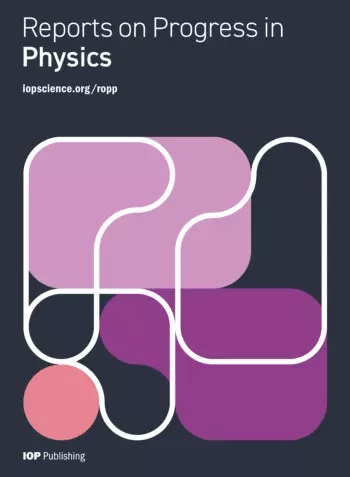Active phase separation: new phenomenology from non-equilibrium physics
IF 20.7
1区 物理与天体物理
Q1 PHYSICS, MULTIDISCIPLINARY
引用次数: 0
Abstract
In active systems, whose constituents have non-equilibrium dynamics at local level, fluid-fluid phase separation is widely observed. Examples include the formation of membraneless organelles within cells; the clustering of self-propelled colloidal particles in the absence of attractive forces, and some types of ecological segregation. A schematic understanding of such active phase separation was initially borrowed from what is known for the equilibrium case, in which detailed balance holds at microscopic level. However it has recently become clear that in active systems the absence of detailed balance, although it leave phase separation qualitatively unchanged in some regimes (for example domain growth driven by interfacial tension via Ostwald ripening), can in other regimes radically alter its phenomenology at mechanistic level. For example, microphase separation can be caused by reverse Ostwald ripening, a process that is hard to imagine from an equilibrium perspective. This and other new phenomena arise because, instead of having a single, positive interfacial tension like their equilibrium counterparts, the fluid-fluid interfaces created by active phase separation can have several distinct interfacial tensions governing different properties, some of which can be negative. These phenomena can be broadly understood by studying continuum field theories for a single conserved scalar order parameter (the fluid density), supplemented with a velocity field in cases where momentum conservation is also present. More complex regimes arise in systems described by multiple scalar order parameters (especially with nonreciprocal interactions between these); or when an order parameter undergoes both conserved and non-conserved dynamics (such that the combination breaks detailed balance); or in systems that support orientational long-range order in one or more of the coexisting phases. In this Review, we survey recent progress in understanding the specific role of activity in phase separation, drawing attention to many open questions. We focus primarily on continuum theories, especially those with a single scalar order parameter, reviewing both analytical and numerical work. We compare their predictions with particle-based models, which have mostly been studied numerically although a few have been explicitly coarse-grained to continuum level. We also compare, where possible, with experimental results. In the latter case, qualitative comparisons are broadly encouraging whereas quantitative ones are hindered by the dynamical complexity of most experimental systems relative that of simplified (particle-level or continuum) models of active matter.主动相分离:来自非平衡物理的新现象学
在主动系统中,其组分在局部水平上具有非平衡动力学,流体-流体相分离被广泛观察到。例子包括细胞内无膜细胞器的形成;在没有吸引力的情况下,自行推进的胶体粒子聚集,以及某些类型的生态隔离。这种主动相分离的示意图最初是从已知的平衡情况中借来的,其中详细的平衡保持在微观水平上。然而,最近已经清楚的是,在活性体系中,尽管在某些制度下(例如通过奥斯特瓦尔德成熟由界面张力驱动的畴生长),缺乏详细的平衡使相分离在质量上保持不变,但在其他制度下,在机制层面上可以从根本上改变其现象学。例如,微相分离可以由反向奥斯特瓦尔德成熟引起,从平衡的角度来看,这是一个很难想象的过程。这种现象和其他新现象的出现,是因为主动相分离产生的流体-流体界面可以有几个不同的界面张力,这些张力控制着不同的性质,其中一些可以是负的,而不是像它们的平衡对应物那样具有单一的正界面张力。这些现象可以通过研究单一守恒标量阶参数(流体密度)的连续介质场理论,在动量守恒的情况下补充速度场,得到广泛的理解。更复杂的制度出现在由多个标量序参数描述的系统中(特别是这些参数之间的非互反相互作用);或者当一个序参数同时经历守恒和非守恒动力学时(这样的组合打破了详细的平衡);或者在一个或多个共存阶段中支持定向远程顺序的系统中。在这篇综述中,我们综述了近年来在理解活性在相分离中的具体作用方面的进展,并提出了许多悬而未决的问题。我们主要关注连续统理论,特别是那些具有单一标量阶参数的理论,回顾了分析和数值工作。我们将他们的预测与基于粒子的模型进行比较,后者主要是在数值上进行研究,尽管有一些已经明确地粗粒度到连续体水平。在可能的情况下,我们还与实验结果进行比较。在后一种情况下,定性比较大体上是令人鼓舞的,而定量比较则受到大多数实验系统相对于简化(粒子级或连续体)活性物质模型的动态复杂性的阻碍。
本文章由计算机程序翻译,如有差异,请以英文原文为准。
求助全文
约1分钟内获得全文
求助全文
来源期刊

Reports on Progress in Physics
物理-物理:综合
CiteScore
31.90
自引率
0.00%
发文量
45
审稿时长
6-12 weeks
期刊介绍:
Reports on Progress in Physics is a highly selective journal with a mission to publish ground-breaking new research and authoritative invited reviews of the highest quality and significance across all areas of physics and related areas. Articles must be essential reading for specialists, and likely to be of broader multidisciplinary interest with the expectation for long-term scientific impact and influence on the current state and/or future direction of a field.
 求助内容:
求助内容: 应助结果提醒方式:
应助结果提醒方式:


